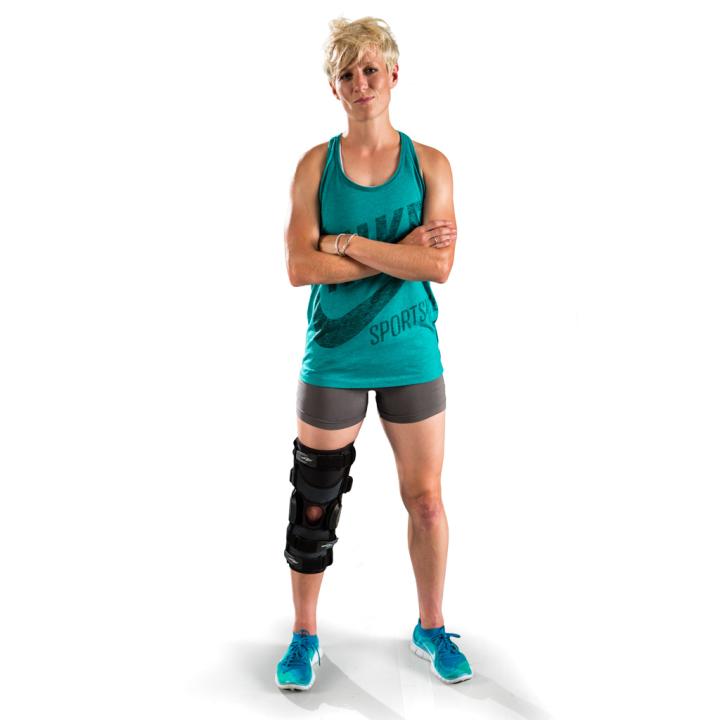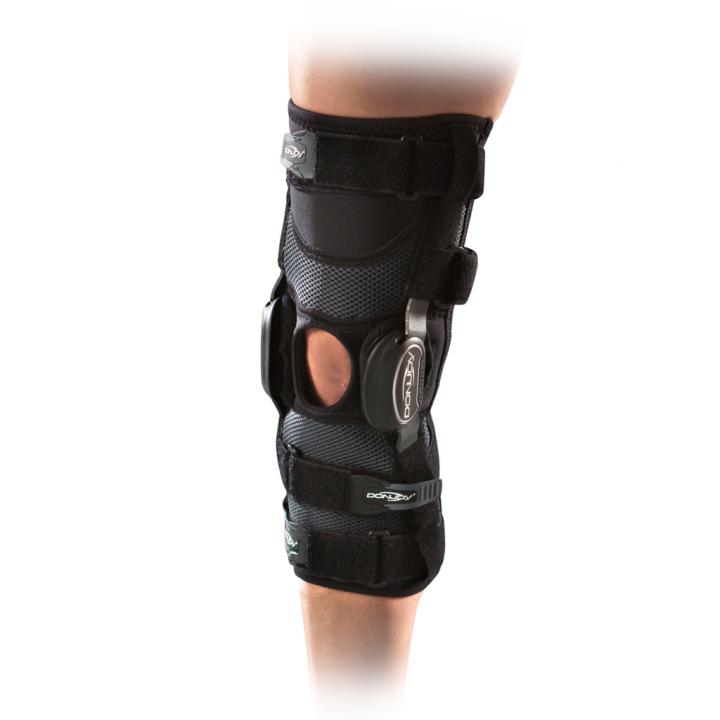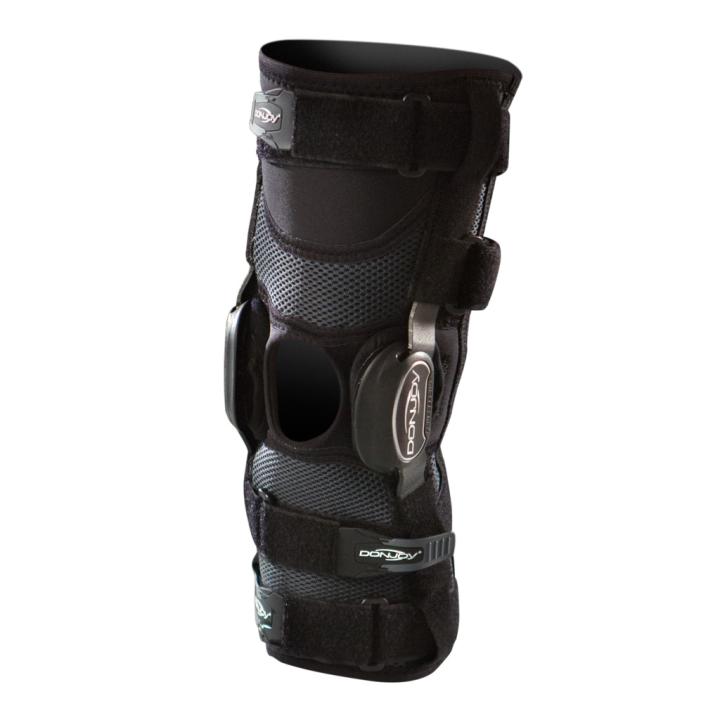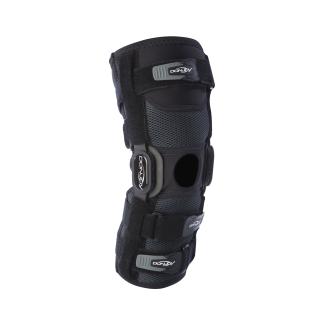“I have had two major injuries during my career—both ACL tears. There is a lot of pressure inside and outside of schools and organizations to recover quickly, which I appreciate, but it’s up to young athletes, parents and coaches to take steps to recover safely and guard against injury and re-injury. This will only allow for a stronger, better return to sport in the long run.”
Playmaker II FourcePoint






Playmaker II FourcePoint

Knee injuries can stop you. Preventing injury or re-injury can keep you moving. Playmaker II FourcePoint, engineered by DonJoy, increases flexion angles and reduces the risk of ACL injury. So go ahead and say it; I can recover. I can train. I can play.
Why Playmaker II FourcePoint?
- Women are 2 to 10x more likely to injure their ACL1
- A person who has torn their ACL has 15x greater risk of a second ACL injury during initial 12-months after ACL reconstruction2
- 50 percent of ACL injuries occur in 15-25-year olds3
- 60-80 percent of ACL injuries are non-contact related4
- Risk of ACL injury to the opposing knee (opposite knee) is two times that of the reconstructed knee5
- Psychological factors, primarily fear of re-injury, influence the ability to return to play6
Support Guide
MANAGING ACL INJURIES
Your options for managing your ACL injury depend on several factors, including how severe the injury is and your lifestyle. Read More...
"I have had two major injuries during my career—both ACL tears. There is a lot of pressure inside and outside of schools and organizations to recover quickly, which I appreciate, but it’s up to young athletes, parents and coaches to take steps to recover safely and guard against injury and re-injury. This will only allow for a stronger, better return to sport in the long run.
Megan Rapinoe
U.S. Soccer Player
Olympic Gold Medalist
- Videos
- Features & Benefits
- Part Numbers
- Related Products
- Documents
- References
- Testimonials

Train, Recover, Overcome With Playmaker II FourcePoint

Megan Rapinoe's Story of Injury and Recovery

FourcePoint Technology

Playmaker II Fitting
Recover
- FourcePoint Technology increases flexion angles (minimizes time spent in “at risk” position7
- Improves joint mechanics in both surgical and non-surgical knee8
- Immeasurable comfort; Hi10 (high tenacity nylon/spandex fabric—posterior) offers unmatched comfort and fit
- Just plain “easy;” molded strap tabs allow quick and easy strap adjustments to deliver a secure and comfortable fit
- “Cooler” experience; advanced spacer fabric promotes a “cool” environment for activities on all levels
Train both knees with One1 Brace
- Preventative use for non-contact sports with FourcePoint Technology
- 60 percent decrease in non-contact ACL injury rate in both knees (one brace protects both knees9
- Training effects retained by about 50 percent while not wearing the brace9
Ordering Information
| Part Number | Description | Size |
|---|---|---|
| 11-3504-1 | Playmaker II FourcePoint | XS |
| 11-3504-2 | Playmaker II FourcePoint | S |
| 11-3504-3 | Playmaker II FourcePoint | M |
| 11-3504-4 | Playmaker II FourcePoint | L |
| 11-3504-5 | Playmaker II FourcePoint | XL |
| 11-3504-6 | Playmaker II FourcePoint | XXL |
| 11-3504-7 | Playmaker II FourcePoint | XXXL |
Sizing Chart
Take the measurement of your thigh and calf 6" above and below your kneecap using a flexible type tape measure. Use the circumference you measure here to choose your size.
| Size | Thigh | Knee Center | Calf |
|---|---|---|---|
| XS | 13" - 15.5" (33-39 cm) | 12" - 13" (30-33 cm) | 10" - 12" (25-30 cm) |
| S | 15.5" - 18.5" (39-47 cm) | 13" - 14" (33-35 cm) | 12" 14" (30-35 cm) |
| M | 18.5" - 21" (47-53 cm) | 14" - 15" (35-38 cm) | 14" - 16" (35-40 cm) |
| L | 21" - 23.5" (53-60 cm) | 15" - 17" (38-43 cm) | 16" - 18" (40-45cm) |
| XL | 23.5" - 26.5" (60-67 cm) | 17" - 19" (43-48 cm) | 18" - 20" (45-50 cm) |
| XXL | 26.5" - 29.5" (67-75 cm) | 19" - 21" (48-53 cm) | 20" - 22" (50-55 cm) |
| XXXL | 29.5" - 32" (75-83 cm) | 21" - 23" (53-58 cm) | 22" - 24" (55-60 cm) |
1. Silvers HJ, Mandelbaum BR, Prevention of Anterior Cruciate Ligament Injury in the Female Athlete, BrJ SportsMed.2007; 41(Suppl): 152-159.
2. Paterno MV. Paper #2. Presented AOSSM Annual Meeting; July 11-14, 2013; Chicago.
3. Griffin LY, Albohm MJ, Arendt, EA, et al. Understanding and Preventing Noncontact Anterior Cruciate Ligament Injuries: A Review of the Hunt Valley II Meeting, January 2005. American Journal of Sports Medicine. 2006 34:9. 1512-1532.
4. Arendt EA, Agel J, Dick R. Anterior cruciate ligament injury patterns among collegiate men and women. Journal of Athletic Training, 1999; 34(2):86-92.
5. Wright RW, Magnussen RA, Dunn WR, Spindler KP, Ipsilateral Graft and Contralateral ACL Rupture at Five Years or More Following ACL Reconstruction. Journal of Bone and Joint Surgery, Am. 2011;93:1159-1165.
6. Spindler et al. Return to High School and College-Level Football After Anterior Cruciate Ligament Reconstruction. Am J Sports Med. Published online Aug. 24, 2012.
7. Yu B, Herman D, Preston J, Lu W, Kirkendall DT, Garrett WE. Immediate Effects of a Knee Brace with a Constraint to Knee Extension on Knee Kinematics and Ground Reaction Forces in a Stop-Jump Task. AJSM. 2004; 32:1136-1143.
8. Queen R, Butler RJ, Dai B, Garrett WE. Effects of Knee Extension Constraint Bracing on Lower Extremity Motion Patterns in Post-ACL Reconstruction Patients. Interium Report of 6-12 month data from the ongoing study, 2012
9. Yu B. Training Effects of a Knee Extension Constraint Brace on Lower Extremity Motion Patterns and the Risk for Non-Contact ACL Injury. Feagin Leadership Forum. Duke Sports Medicine Center, 2010.
